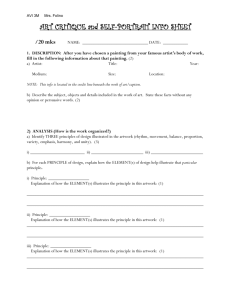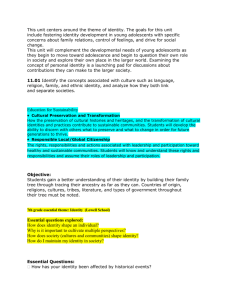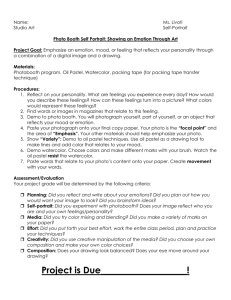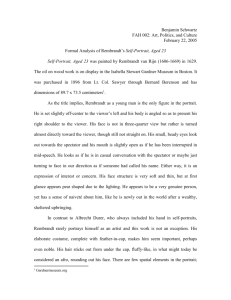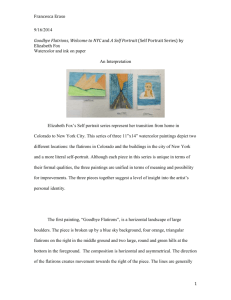SELF-PORTRAITS What is a self-portrait ? A self
advertisement
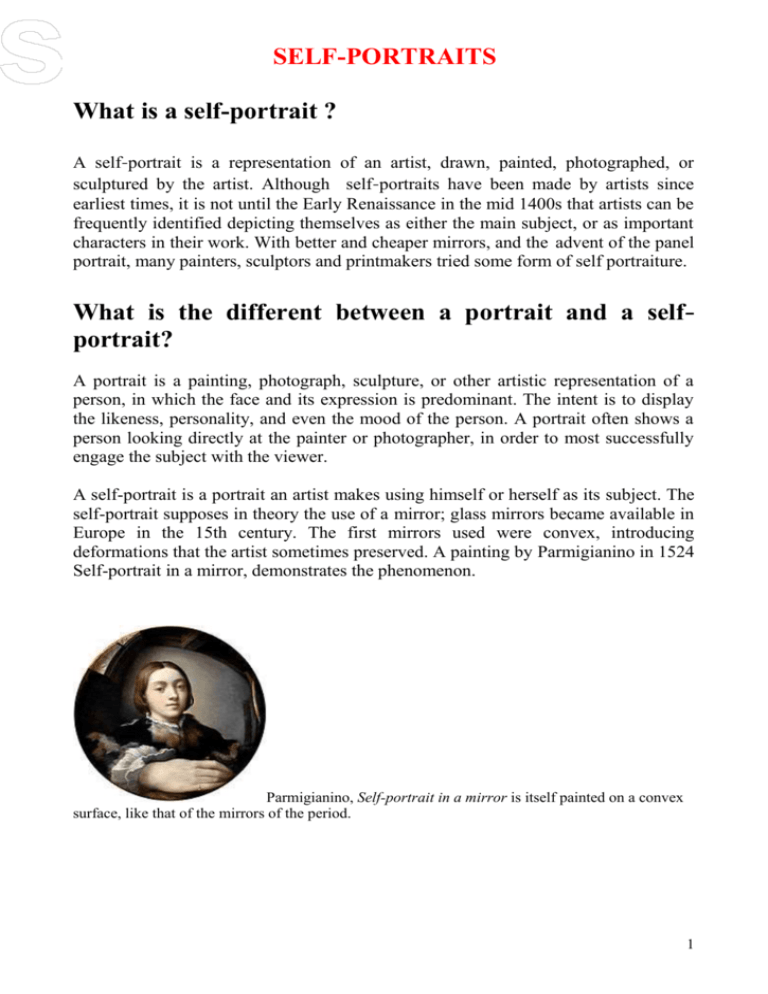
SELF-PORTRAITS What is a self-portrait ? A self-portrait is a representation of an artist, drawn, painted, photographed, or sculptured by the artist. Although self-portraits have been made by artists since earliest times, it is not until the Early Renaissance in the mid 1400s that artists can be frequently identified depicting themselves as either the main subject, or as important characters in their work. With better and cheaper mirrors, and the advent of the panel portrait, many painters, sculptors and printmakers tried some form of self portraiture. What is the different between a portrait and a selfportrait? A portrait is a painting, photograph, sculpture, or other artistic representation of a person, in which the face and its expression is predominant. The intent is to display the likeness, personality, and even the mood of the person. A portrait often shows a person looking directly at the painter or photographer, in order to most successfully engage the subject with the viewer. A self-portrait is a portrait an artist makes using himself or herself as its subject. The self-portrait supposes in theory the use of a mirror; glass mirrors became available in Europe in the 15th century. The first mirrors used were convex, introducing deformations that the artist sometimes preserved. A painting by Parmigianino in 1524 Self-portrait in a mirror, demonstrates the phenomenon. Parmigianino, Self-portrait in a mirror is itself painted on a convex surface, like that of the mirrors of the period. 1 Why do artists make self-portraits? When artists make self-portraits, they may be asking themselves a very basic but difficult question: Who am I? Does this artistic method help people to understand themselves better? Why is that important? Since the Renaissance, artists have used self-portraits to answer the basic question: Who am I? A mirror or a photograph can tell a person what he or she looks like, but that outer image rarely reflects the whole self. Self-portraiture asks artists to think carefully about personality, character, mood, and physical appearance in order to make decisions about how to represent themselves. For each self-portrait, the artist must ask: what expression, posture, clothing, setting, colours, texture, style, and material best conveys the real me? Here are some practical reasons why artists make self-portraits: They get a model who is always available and works for free. Self-portraits are a good way for artists to practice representing different expressions and moods. Self-portraits advertise an artist's skill. A potential customer can compare the image in the self-portrait to the actual person and decide on the spot to hire the artist—or not. Self-portraits live on. They preserve memories and let the artist leave his or her image behind—a way of fulfilling the human quest for immortality. What types of self-portraits are there? An art critic separates two basic forms of the self-portrait: "professional" portraits, in which the artist is depicted at work, and "personal" portraits, which reveal moral and psychological features. Here is a more detailed taxonomy: 1. the "inserted" self-portrait, where the artist inserts his or her own portrait into, for example, a group of characters related to some subject; 2. the "prestigious, or symbolic" self-portrait, where an artist depicts him or herself in the guise of a historical person or religious hero; 3. the "group portrait" where the artist is depicted with members of family or other real people; 4. the "separate or natural" self-portrait, where the artist is depicted alone. However these classes are not so rigid, in fact many artists manage to combine several of them. A self-portrait may be a portrait of the artist, or a portrait included in a larger work, including a group portrait. Many painters are said to have included depictions of specific individuals, including themselves, in painting figures in religious or other types of composition not intended to depict the actual persons as themselves. Often these are just faces in a crowd, often at the corner of the work, but a particular hybrid 2 genre developed where historical scenes were depicted using a number of actual persons as models, often including the artist, giving the work a double function as portrait and history painting. Inserted self-portraits The great Italian painters of the Renaissance made comparatively few formal painted self-portraits, but often included themselves in larger works. a) Masaccio(14011428) depicted himself as one of the apostoles in the painting of the Brancacci Chapel, b) Sandro Botticelli’s painting of the Adoration of the Magi (1475, tempera on canvas, Florence, Uffizi Gallery) has an “inserted self-portrait”. The position in the (right) corner, and the gaze out to the viewer, are very typical of such self-portraits; as a spectator of the Adoration of the Magi, who turns from the scene to look at us. c) Piero della Francesca as a sleeping soldier in his Resurrection (1463, fresco , San Sepolcro). Masaccio inserted self-portrait from the Brancacci Chapel frescoes. Piero della Francesca as sleeping soldier in his Resurrection, 1463 fresco, Sansepolcro. Sandro Botticelli’s painting of the Adoration of the Magi has an “inserted self-portrait”. 3 Painters at work Self-portraits of the artist at work were the commonest form of medieval self-portrait, and these have continued to be popular, with a specially large number from the eighteen century on. A famous large view of the artist in his studio is The Painter’s atelier by Gustave Courbet (1855, Paris, Musée d’Orsay), an immense “Allegory” of objects and characters amid which the painter sits. Other meanings A self-portrait can be as varied and limitless as our imagination. A self-portrait can be an exact likeness or an abstract whirl of thoughts and feelings. It has the potential to create a myth, tell a story, suggest sadness or jubilation. A self-portrait is a person’s version of himself/herself. A classification includes these typologies 1. Analysis: A self-portrait is an exploration of your face, body and personality. 2. Authorship: A self-portrait is an historical record of the person that made it, left behind for posterity. 3. Autobiography: A self-portrait can be a visual journal documenting something that is happening or has happened in your life. The self-portraits of many contemporary artists and modernists often are characterized by a strong sense of narrative which recalls fantasy, role-playing and fiction. 4. Advertising: A self-portrait is a demonstration of style and skill to show to prospective clients. The self-portrait can be a very effective form of advertising for an artist, especially for a portrait painter. With the advent of regular Academy shows, many artists tried to produce memorable self-portraits to make an impression on the artistic stage. 5. Availability: A self-portrait can be a way to experiment with pose and technique using a readily available model. 4 What does a self-portrait tell the viewer? The artist had to think and decide on the following: How large or small to make a self-portrait?. People will feel very different standing and peering at a tiny image, than standing back and gazing up at a huge one. Where to place the figure?. Usually the face is the focal point of a portrait and is positioned somewhere near the middle, but it doesn’t have to be necessarily located there. A self-portrait can be a detail of the artist’s face or can represent his three dimensional body . Is there a background behind the figure?. Some artists use a plain colour in the background to heighten the atmosphere of their portrait. Clothes?. Some artists dress up for their portraits and don’t just wear their normal painting clothes. What do the clothes say about a person? Are they an indication of one’s true self or are they a disguise? Props in the portrait give a sense of interests or personality. An artist may be holding something or include objects in a more abstract or symbolic way. Pose?. What does artist’s body language communicate? Facial expression?. Do they indicate how the artist is feeling? Artist at work?. Sometimes you can tell a self-portrait because the artist has depicted themselves working at an easel or on paper. Is the artist the only figure in a self-portrait?. We usually think of a self-portrait as being an image just of the artist but if someone else is included, a partner or family member for example, the self-portrait can also be about the relationship between the artist and that person. 5
